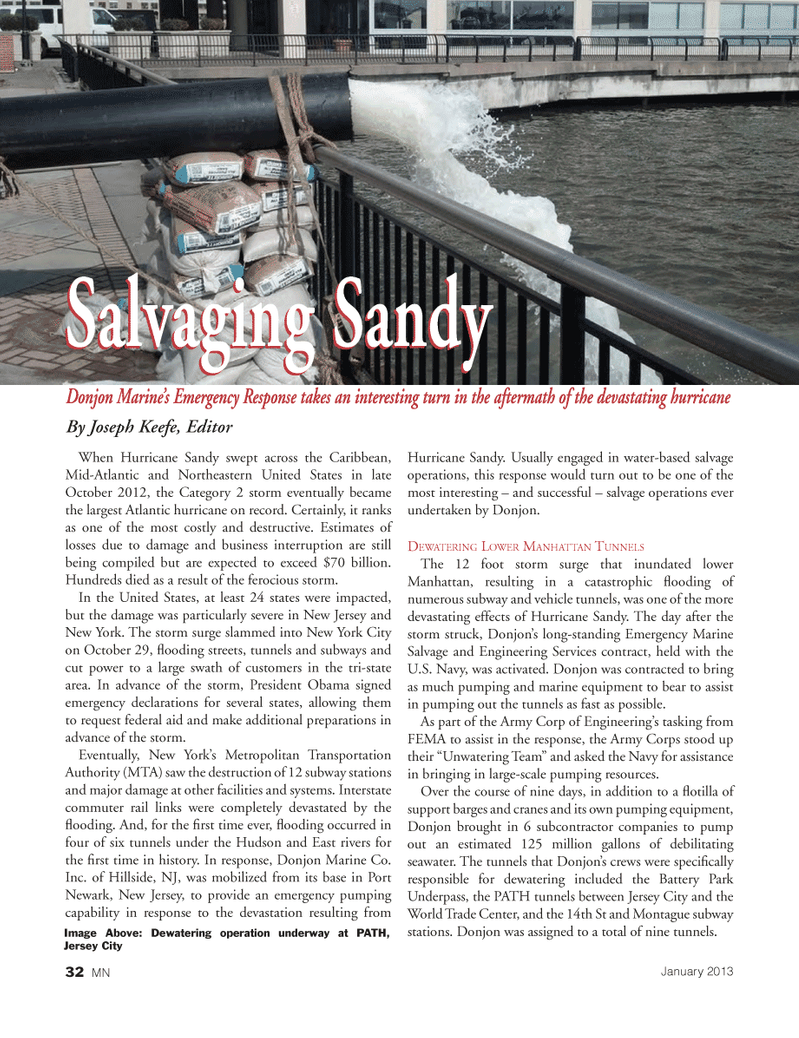
Page 32: of Marine News Magazine (January 2013)
Training and Education
Read this page in Pdf, Flash or Html5 edition of January 2013 Marine News Magazine
When Hurricane Sandy swept across the Caribbean, Mid-Atlantic and Northeastern United States in late October 2012, the Category 2 storm eventually became the largest Atlantic hurricane on record. Certainly, it ranks as one of the most costly and destructive. Estimates of losses due to damage and business interruption are still being compiled but are expected to exceed $70 billion. Hundreds died as a result of the ferocious storm. In the United States, at least 24 states were impacted, but the damage was particularly severe in New Jersey and New York. The storm surge slammed into New York City on October 29, ß ooding streets, tunnels and subways and cut power to a large swath of customers in the tri-state area. In advance of the storm, President Obama signed emergency declarations for several states, allowing them to request federal aid and make additional preparations in advance of the storm. Eventually, New YorkÕs Metropolitan Transportation Authority (MTA) saw the destruction of 12 subway stations and major damage at other facilities and systems. Interstate commuter rail links were completely devastated by the ß ooding. And, for the Þ rst time ever, ß ooding occurred in four of six tunnels under the Hudson and East rivers for the Þ rst time in history. In response, Donjon Marine Co. Inc. of Hillside, NJ, was mobilized from its base in Port Newark, New Jersey, to provide an emergency pumping capability in response to the devastation resulting from Hurricane Sandy. Usually engaged in water-based salvage operations, this response would turn out to be one of the most interesting Ð and successful Ð salvage operations ever undertaken by Donjon. DEWATERING LOWER MANHATTAN TUNNELSThe 12 foot storm surge that inundated lower Manhattan, resulting in a catastrophic ß ooding of numerous subway and vehicle tunnels, was one of the more devastating effects of Hurricane Sandy. The day after the storm struck, DonjonÕs long-standing Emergency Marine Salvage and Engineering Services contract, held with the U.S. Navy, was activated. Donjon was contracted to bring as much pumping and marine equipment to bear to assist in pumping out the tunnels as fast as possible. As part of the Army Corp of EngineeringÕs tasking from FEMA to assist in the response, the Army Corps stood up their ÒUnwatering TeamÓ and asked the Navy for assistance in bringing in large-scale pumping resources. Over the course of nine days, in addition to a ß otilla of support barges and cranes and its own pumping equipment, Donjon brought in 6 subcontractor companies to pump out an estimated 125 million gallons of debilitating seawater. The tunnels that DonjonÕs crews were speciÞ cally responsible for dewatering included the Battery Park Underpass, the PATH tunnels between Jersey City and the World Trade Center, and the 14th St and Montague subway stations. Donjon was assigned to a total of nine tunnels. Salvaging Sandy Salvaging Sandy Salvaging Sandy Salvaging Sandy Donjon Marine?s Emergency Response takes an interesting turn in the aftermath of the devastating hurricane Donjon Marine?s Emergency Response takes an interesting turn in the aftermath of the devastating hurricane By Joseph Keefe, Editor Image Above: Dewatering operation underway at PATH, Jersey CityJanuary 2013 32 MNMN Jan2013 Layout 32-42.indd 32MN Jan2013 Layout 32-42.indd 321/8/2013 4:24:03 PM1/8/2013 4:24:03 PM

 31
31

 33
33
